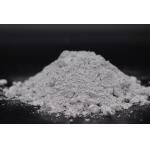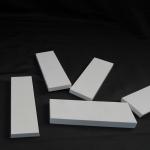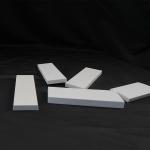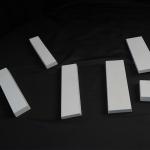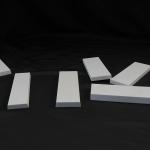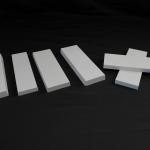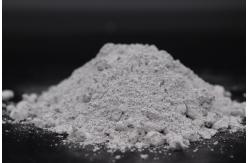Product Description:
High alumina cement (formerly known as alumina cement) is a
hydraulic cementitious material made from alumina and lime as raw
materials, formulated in a certain proportion, and calcined and
finely ground to produce aluminate as the main mineral component.
It is also known as aluminate cement.
There are various types of high alumina cement, which can be
classified into CA-50, CA-70, and CA-80 types based on the
differences in aluminum and calcium content. Among them, CA-50 is
known for its yellow tone, and its raw materials mainly come from
alumina and limestone. CA-70 is favored for its low impurities,
superior setting characteristics, and fire resistance compared to
CA-50 refractory cement, and is often used as a binder for low
cement refractory castables. As for CA-80 high alumina cement, its
aluminum content is as high as 80% and it contains α - AL2O3 micro
powder, so it often serves as a binder in high-end refractory
castables. Thanks to their high aluminum content and low calcium
content, these two types of cement can significantly improve the
setting speed and medium temperature strength of refractory
castables, while extending their service life for later strength.
Features:
1. Fast hardening and early strength: High alumina cement is mainly
composed of calcium aluminate, and its early strength increases
rapidly. It can reach the standard strength in 3 days and is
suitable for emergency repair projects or scenarios with high early
strength requirements.
2. High hydration heat: early concentrated release of a large
amount of heat, suitable for winter construction, but can easily
cause temperature difference stress in concrete, so it is not
suitable for large volume engineering or high temperature and humid
environments.
3. Resistant to sulfate corrosion: Cement stone has a dense
structure and low calcium oxide content, with strong resistance to
sulfate corrosion and suitable for harsh chemical environments.
4. Excellent heat resistance: Solid phase sintering bonding is
formed at high temperatures to maintain stable strength, suitable
for refractory concrete (such as metallurgical furnace lining).
Technical Parameters:
| Brand | CA-70 | CA-75 | CA-80 |
| Chemical composition (%) |
Al2O3 (%) min | 68.5-70.5 | 73.5-75.5 | 78.5-80.5 |
CaO (%) max | 29.5-30.5 | 23.5-24.5 | 17.5-19.5 |
SiO2 (%) max | 0.5 | 0.45 | 0.35 |
Fe2O3 (%) max | 0.3 | 0.25 | 0.26 |
Specific surface area (m2/kg) min | 420 | 420 | 420 |
Initial setting time: (h: min) | ≥0:30 | ≥0:30 | ≥0:30 |
Final setting time: (h: min) | <6:00 | <6:00 | <6:00 |
Bending Strength (Mpa) |
24 hr | ≥7.0 | ≥6.0 | ≥4.0 |
72 hr | ≥12.0 | ≥10.0 | ≥5.0 |
Compressive strength (Mpa) |
24 hr | ≥45.0 | ≥40.0 | ≥25.0 |
72 hr | ≥65.0 | ≥62.0 | ≥30.0 |
Refractoriness (℃) | 1690 | 1730 | 1790 |
Precautions and application guidelines for the use of high alumina
cement:
1. High alumina cement is strictly prohibited from being mixed with
Portland cement or lime, and must not come into contact with
uncured Portland cement concrete to avoid instant setting that may
prevent construction and affect strength. The mixing equipment must
be thoroughly rinsed before use.
2. High alumina cement is not suitable for projects that come into
contact with highly alkaline solutions.
3. Due to the fact that the hydration heat of high alumina cement
is mainly concentrated in the early stages of release, watering and
curing should be carried out immediately from the beginning of
hardening, and attention should be paid not to be used for pouring
large volume concrete.
4. The later strength of high alumina cement concrete will
significantly decrease, so the design should be based on the
minimum stable strength. The strength value can be determined by
placing the specimen in water at 50 ± 2 ℃ for curing after
demolding, and taking the lower of the 7-day and 14 day strength
values.
If steam curing is used to accelerate concrete hardening, the
curing temperature should be controlled within 50 ℃.
When used in reinforced concrete, the thickness of the steel
reinforcement protective layer must be greater than or equal to 3
centimeters.
7. No additives shall be added to high alumina cement without
sufficient testing.
8. High alumina cement should not come into direct contact with
uncured Portland cement concrete, but can come into contact with
Portland cement concrete with demolding strength, but attention
should be paid to avoiding long-term moisture at the joint.
The most suitable hardening temperature for high alumina cement is
about 15 ℃, and the ambient temperature during construction should
not exceed 25 ℃ to prevent crystal transformation and strength
reduction. In addition, concrete mixed with high alumina cement is
not suitable for steam curing.
10. Due to the influence of factors such as crystal transformation
and aging of aluminate gel, the long-term strength of high alumina
cement shows a downward trend. Therefore, when used in engineering,
the design should be based on the minimum stable strength and its
specific value should be determined through experiments.
Packaging Standards and Storage Methods:
Usually, moisture-proof paper bags are used for packaging, which
consist of four layers of ordinary packaging paper and three layers
of moisture-proof paper to ensure the moisture-proof performance of
cement. The net weight standard for each bag is 50 ± 1 kilogram,
and packaging can also be customized according to customer needs.
